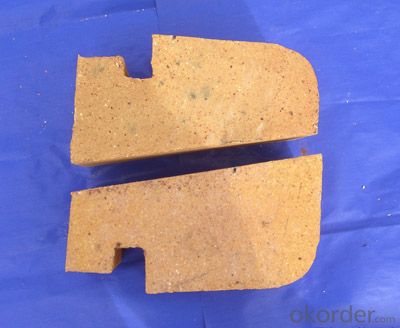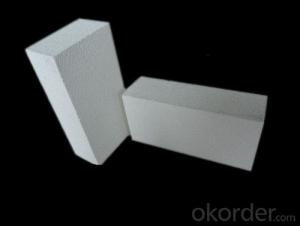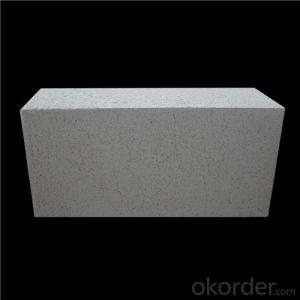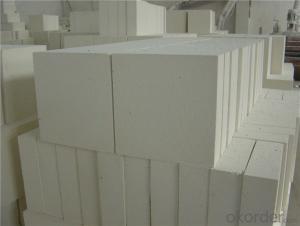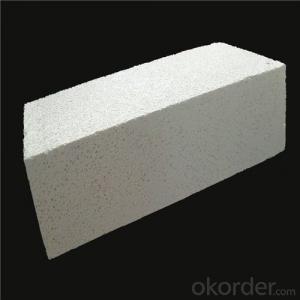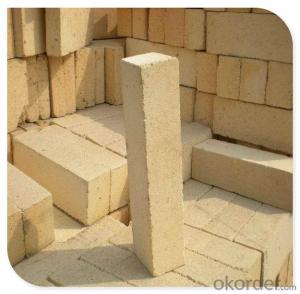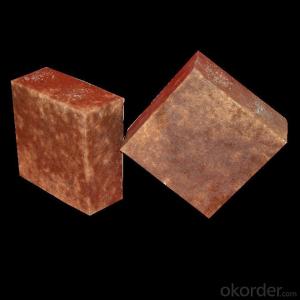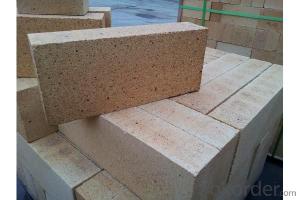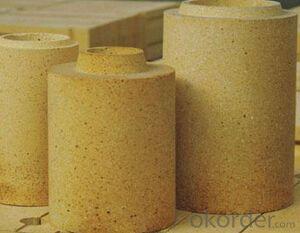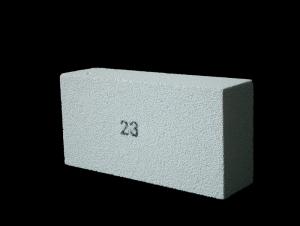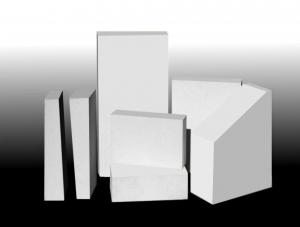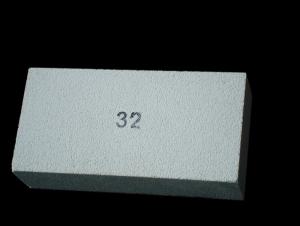Insulating Fire Brick for Hot Blast Stove Refractory Applications
- Loading Port:
- China Main Port
- Payment Terms:
- TT OR LC
- Min Order Qty:
- -
- Supply Capability:
- -
OKorder Service Pledge
OKorder Financial Service
You Might Also Like
Specifications
Fire brick1.ISO 9001 approved,
2.With high quality and competitive price,
3.Standard and special shape.
Fire-clay refractory brick.
1. N-1
AL2O3 (%)>42
Refractoriness >1750
Refractoriness under load KD>1400
Permanent linear change onreheating
1500*2h
1450*2h
1400*2h:+0.1; -0.4
Apparent Porosity(%)<22
Cold crushing strength (Mpa)>29.4
2. N-2a
AL2O3 (%)>40
Refractoriness >1730
Refractoriness under load KD>1350
Permanent linear change onreheating
1500*2h
1450*2h
1400*2h:+0.1; -0.5
Apparent Porosity(%)<24
Cold crushing strength (Mpa)>24.5
High-alumina refractory brick
1. LZ-75
AL2O3 (%)>75
Refractoriness>1790
Refractoriness under load KD>1520
Permanent linear change onreheating
1500*2h:+0.1; -0.4
1450*2h
1400*2h
Apparent Porosity(%)<23
Cold crushing strength (Mpa)>53.9
2. LZ-65
AL2O3 (%)>65
Refractoriness >1790
Refractoriness under load KD>1500
Permanent linear change onreheating
1500*2h:+0.1; -0.4
1450*2h
1400*2h
Apparent Porosity(%)<23
Cold crushing strength (Mpa)>49
3.LZ-55
AL2O3 (%)>55
Refractoriness >1770
Refractoriness under load KD>1470
Permanent linear change onreheating
1500*2h:+0.1; -0.4
1450*2h
1400*2h
Apparent Porosity(%)<22
Cold crushing strength (Mpa)>44.1
4.LZ-48
AL2O3 (%)>48
Refractoriness >1750
Refractoriness under load KD>1420
Permanent linear change onreheating
1500*2h
1450*2h:+0.1; -0.4
1400*2h
Apparent Porosity(%)<22
Cold crushing strength (Mpa)>39.2
Fire clay brick SK-32 | |
Item | Standard |
AI2O3(%) | 30 |
Fe2O3 (%) | 3.5 |
Refractoriness (SK) | 32 |
Refractoriness under load, 0.2MPa, Ta, (°C) | 1300 |
Porosity (%) | 22-26 |
Bulk density (g/cm³) | 2.05 |
Cold crushing strength (MPa) | 25 |
Thermal expansion at 1000°C (%) | 0.6 |
Fire clay brick SK-34 | |
Item | Standard |
AI2O3(%) | 38 |
Fe2O3 (%) | 2.5 |
Refractoriness (SK) | 34 |
Refractoriness under load, 0.2MPa, Ta, (°C) | 1350 |
Porosity (%) | 19-23 |
Bulk density (g/cm³) | 2.10-2.15 |
Cold crushing strength (MPa) | 25 |
Thermal expansion at 1000°C (%) | 0.6 |
Fire clay brick SK-36 | |
Item | Standard |
AI2O3(%) | 50 |
Fe2O3 (%) | 2 |
Refractoriness (SK) | 36 |
Refractoriness under load, 0.2MPa, Ta, (°C) | 1450 |
Porosity (%) | 20-24 |
Bulk density (g/cm³) | 2.30-2.40 |
Cold crushing strength (MPa) | 45 |
Thermal expansion at 1000°C (%) | 0.3 |
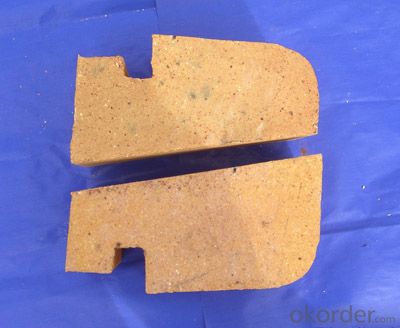
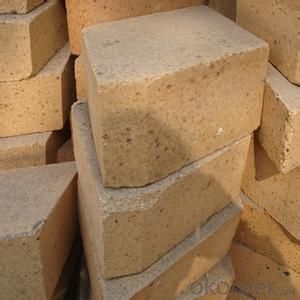
- Q: What are the dimensions of insulating fire bricks?
- Insulating fire bricks typically come in various dimensions, depending on the manufacturer and specific application. However, the most common dimensions for insulating fire bricks are 9" x 4.5" x 2.5" (or 230mm x 114mm x 64mm). These dimensions are standard and widely used in the industry. It is important to note that different projects may require different dimensions, and it is always recommended to consult the manufacturer or supplier for the specific dimensions that best suit your needs.
- Q: Do insulating fire bricks require any special fireproofing treatments?
- No, insulating fire bricks do not require any special fireproofing treatments. Insulating fire bricks are made from lightweight materials with high insulating properties, such as refractory clay or ceramic fibers. These materials are inherently fire-resistant and can withstand high temperatures without the need for additional fireproofing treatments. However, it is important to ensure proper installation and usage of insulating fire bricks to maximize their effectiveness and longevity.
- Q: What is the specific heat capacity of insulating fire bricks?
- The specific heat capacity of insulating fire bricks may differ depending on their specific composition and manufacturing process. Nevertheless, compared to other brick types, insulating fire bricks generally exhibit a relatively high specific heat capacity. This characteristic enables them to effectively absorb and retain a significant amount of heat energy without experiencing a substantial rise in temperature. Typically, the specific heat capacity of insulating fire bricks falls within the range of 0.8 to 1.2 kilojoules per kilogram per degree Celsius (kJ/kg°C). It should be noted that factors such as brick density, porosity, and temperature range of use can also influence the specific heat capacity.
- Q: Can insulating fire bricks be used in residential applications?
- Yes, insulating fire bricks can be used in residential applications. Insulating fire bricks are lightweight and have excellent thermal insulation properties, making them suitable for various residential uses. They can be used to insulate fireplaces, wood-burning stoves, and chimneys, helping to increase energy efficiency and reduce heat loss. Additionally, insulating fire bricks can be utilized in the construction of pizza ovens and outdoor grills, providing excellent heat retention and insulation. Their ability to withstand high temperatures makes them ideal for these applications. Overall, insulating fire bricks offer homeowners a reliable and durable solution for enhancing the insulation and heat retention in residential settings.
- Q: Can insulating fire bricks be used for insulation in oil refineries?
- Yes, insulating fire bricks can be used for insulation in oil refineries. These bricks have excellent thermal insulation properties and can withstand high temperatures, making them suitable for insulation applications in oil refineries where heat is generated. They can help reduce heat loss and increase energy efficiency in the refining process.
- Q: Can insulating fire bricks be used in residential construction?
- Insulating fire bricks, also known as refractory bricks, are primarily designed for high-temperature applications like industrial furnaces and kilns. Their purpose is to withstand extreme heat, have low thermal conductivity, and offer excellent insulation properties. Although insulating fire bricks can be utilized in residential construction, they are not usually the preferred choice for such projects due to various reasons. Firstly, they are considerably more expensive compared to other construction materials available in the market. This cost factor often makes them less desirable for residential projects, where budget considerations are crucial. Secondly, insulating fire bricks are primarily designed to provide thermal insulation in high-temperature environments, which is relatively rare in residential construction. Standard construction materials like concrete blocks, bricks, or insulation boards can usually provide sufficient insulation for residential buildings. Lastly, insulating fire bricks are not as structurally strong as other construction materials, making them less suitable for load-bearing applications in residential construction. These bricks are typically used as a secondary layer or lining in industrial furnaces, rather than being used as the primary building material. In conclusion, although insulating fire bricks can technically be used in residential construction, they are not commonly chosen due to their high cost, limited applicability, and structural limitations. Residential construction typically relies on more cost-effective and versatile materials to meet insulation and structural requirements.
- Q: Can insulating fire bricks be used in lime plants?
- Indeed, insulating fire bricks have the capability to be utilized in lime plants. These bricks are uniquely crafted to possess a remarkably low thermal conductivity, thus enabling them to effectively impede the transfer of heat. In the context of lime plants, where elevated temperatures are necessary for the calcination process, insulating fire bricks can be employed to line the kilns and other zones exposed to high temperatures. By doing so, these bricks aid in the preservation of heat within the lime kilns, resulting in a reduction of energy loss and an enhancement of overall efficiency. Furthermore, insulating fire bricks possess resistance against chemical attacks and are able to endure the harsh conditions experienced in lime plants, rendering them a suitable and appropriate choice for this particular application.
- Q: Can insulating fire bricks be used in the construction of cremation chambers?
- Yes, insulating fire bricks can be used in the construction of cremation chambers. Insulating fire bricks are made from lightweight materials, such as vermiculite or perlite, which have excellent insulating properties. These properties make them suitable for high-temperature applications, such as cremation chambers, where they can help maintain a consistent and controlled temperature. Using insulating fire bricks in the construction of cremation chambers can provide several benefits. Firstly, they can help to improve energy efficiency by reducing heat loss. This can result in lower fuel consumption and cost savings. Secondly, the insulating properties of these bricks can help to maintain a stable temperature inside the cremation chamber, which is important for ensuring efficient and complete combustion of the deceased. Additionally, insulating fire bricks are lightweight and easy to handle, which can make the construction process more convenient and efficient. However, it is important to note that while insulating fire bricks can be used in the construction of cremation chambers, they are typically used in combination with refractory fire bricks. Refractory fire bricks are made from materials, such as clay or silica, that can withstand extremely high temperatures. These bricks are used in the areas of the cremation chamber that experience direct contact with the flames, while insulating fire bricks are used in the areas that require insulation. Overall, insulating fire bricks are a suitable choice for the construction of cremation chambers, as they provide excellent thermal insulation and can contribute to the efficient and controlled operation of the cremation process.
- Q: Are insulating fire bricks porous?
- Yes, insulating fire bricks are porous.
- Q: What is the typical lifespan of insulating fire bricks in high-temperature applications?
- The typical lifespan of insulating fire bricks in high-temperature applications can vary depending on various factors such as the temperature reached, the specific type and quality of the brick, and the conditions under which it is used. However, on average, insulating fire bricks can last anywhere from several years to several decades in high-temperature applications.
Send your message to us
Insulating Fire Brick for Hot Blast Stove Refractory Applications
- Loading Port:
- China Main Port
- Payment Terms:
- TT OR LC
- Min Order Qty:
- -
- Supply Capability:
- -
OKorder Service Pledge
OKorder Financial Service
Similar products
Hot products
Hot Searches
Related keywords




